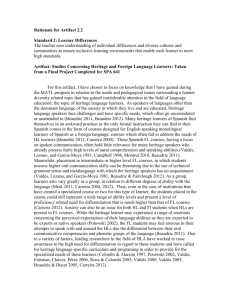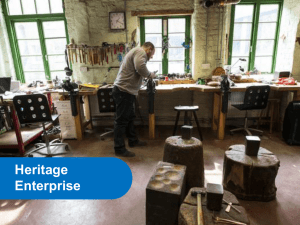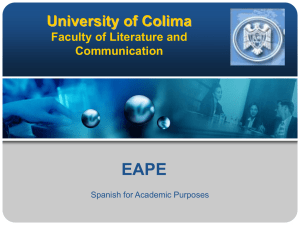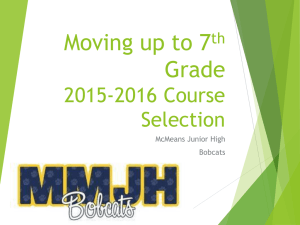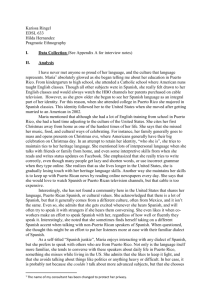Spanish for Heritage Language Learners : Lesson 1
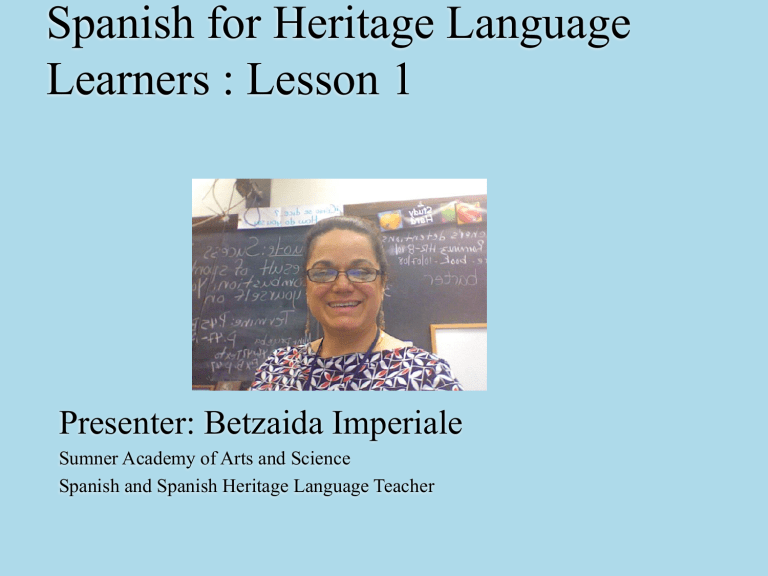
Spanish for Heritage Language
Learners : Lesson 1
Presenter: Betzaida Imperiale
Sumner Academy of Arts and Science
Spanish and Spanish Heritage Language Teacher
Betzaida Imperiale
Born and raised in Puerto Rico
BA Modern Languages - Cum Laude (Italian and
French)
MA in Arts, Spanish /Latin America Literature
PhD in - Grand Canyon University, in progress
Member: MLA, KSWLA, KSDE World
Languages Advisory Committee, Phi Lambda-
Theta
Sumner Academy First Spanish Native Speaker
Program Teacher
Instructor: 11 yrs. Teaching K-14 and 4 yrs.
Teaching Spanish for HL Level I - III
What do you know…?
…about
Language Learners
Second Language Learner (L2)
Exposed to formal second language instruction at an older age
Already have an understanding of the meanings, uses, and purposes of (first) language; they now must… go on to learn how the second language--oral and in print--expresses those purposes, uses, and meanings (Lindfors, 1987).
Heritage Language Learner
(HLL)
1970’s Canada
Since the 1990’s in USA
Exposure to non-English language outside the formal educational system
Anyone who has had in-depth exposure to another language
Hornberger &Wang (2008)
Synonyms
Native speaker
Bilingual
Home background
*Different names, different interpretations
(Valdés, 1996)
Guadalupe Valdés Graphic Organizer
Language Native Foreign Heritage
L1 or L2 (age) L1 (child) L2 (after the first language has been acquired)
L1/L2?
Exposure to target
Language
Full language
Community
Outside of community Limited community
Assist HLL language self assessment
Check point
Students language proficiency (myth vs reality)
Students knowledge about grammar forms
Students skills: performing their knowledge of
Spanish grammar
Students learning style preferences (yes, you have them!)
The number of languages they have studied
Students continuous exposure to the target language
(http://www.carla.umn.edu/strategies/sp_grammar/variety.html)
HL student’s needs
To learn Spanish for academic purpose
understanding language for specific learning goals
Clear future goals
content relevant to learners short and long term goals
Effective language teaching
organizing learning around subject specifics
purposeful activities
Sloan & Porter (2008)
Teacher’s needs…
to learn students culture and learner’s characteristics
to get prepared with unit, lessons and activities with this audience in mind
to ensure a bias free and good quality of learning environment
to revisit and adapt classroom behavior rule
Teacher’s needs…
to discuss and recognize the relevance of achievement/success in class
to relate transferability of knowledge to other courses
to focus on reading for comprehension and understanding (making inferences, critical thinking and critical analisis…)
to write on target language (creative, summarizing and translations)
“Recognizing the Needs and talents of the
Heritage Language Learner”
We are called to:
Blend native and second language methods, not students
Impact the formal studies of the HL
Impart will and motivation toward reading in target language
Improve their reading skills, their development and knowledge to read in another L2
(Berstain, Bruke, Fafre & Delcourt)
Goals and content of instruction
Instructional Strategies
Differentiated
Student-center
Collaborative
Memorization
Higher level thinking skills
Skills
Reading
Writing
Translation
Listening
Speaking
How will/do you teach your HL students?
How proficient are your HL students?
Reading Motivation Assessment Plan Prototype
How do we evaluate HL ability to read?
What are the underlying components of motivation to read?
Are the HL reading motivation equal for the
L2 group? Do they have similar or different reading motivation profiles?
To what degree is motivation related to HL reading ability?
Have students self rate their ability to read.
Provide six reading tasks from basic to more complex.
Provide a reading motivation questionnaire that includes items to measure some theoretical motivation components
R e c o m m e n d a t i o n s
Set-up clear knowledge-based reading goals
Use stimulating activities that connect reading to the students’ lives outside of the classroom or school
Support students autonomy by providing a variety of texts to choose from, based on their capacity and topic of interest
Provide strategy instruction that may help students improve bottom-up and top-down processing
Encourage collaborative learning by allowing students share their opinions on what they read
Create assessment tools easy to students systematically self-monitor what they read and how they read it
Let them know you care about their progress
Explore/focus on production skills: I.e., writing and speaking effectively
References
Kagan, O., & Dillon, K. (2003). A new perspective on teaching Russian Focus on the heritage learner. Heritage Language Journal, Available: http://www.carla.umn.edu/strategies/sp_grammar/variety.html
http://www.ksde.org
http://www.international.ucla.edu/languages/heritagelanguages/journal/article.
asp?parentid=3693
Polinsky, M. & Kagan, O. (2007). Heritage Languages: In the ‘Wild’ and in the Classroom. Language and Linguistics Compass, 1/5: 368–395,
10.1111/j.1749-818x.2007.00022.x
Sloan, Diane, and Porter, Elizabeth (2008). The management of English
Language support in postgraduate business education: the CEM
Model (contextualisation, embedding and mapping), Northumbria
University DOI:10.3794/ijme.72.188, International Journal of
Management Education 7(2)
Valdés, G. (2000). The teaching of heritage languages: an introduction for
Slavic-teaching professionals. The learning and teaching of Slavic languages and cultures, Olga Kagan and Benjamin Rifkin (eds.),
375–403.




